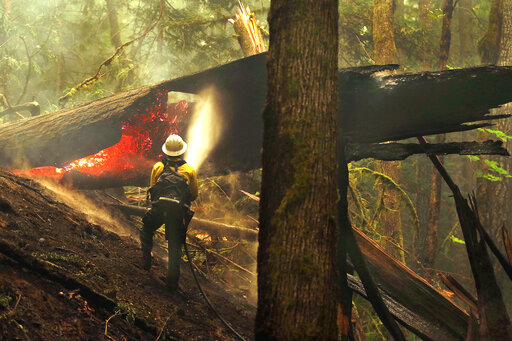SPOKANE, Wash. — The state’s commissioner of Public Lands released a proposal Monday to raise some $63 million each year to fight wildfires and take steps to prevent them in the first place.
Money for the fund will come from a surcharge of $5 per year on each policy sold by property and casualty insurance companies across the state.
Public Lands commissioner Hilary Franz estimated it will cost the average household just over $1 per month, based on one homeowner’s policy and two auto policies.
“That’s cheaper than a Bud Light,” Franz said. “By sharing the burden, we acknowledge that wildfire effects all of us and minimize the cost to each household.”
The bill would be the largest investment Washington has ever made to expand its wildfire team and restore the health of forests, Franz said.
The bill is designed to “reclaim the clear, blue summer skies we know and love,” Franz said.
The bill will be introduced in the state House of Representatives by Rep. Joe Fitzgibbon, D-West Seattle.
Senate Minority Leader Mark Schoesler, R-Ritzville, criticized the bill as a bad idea.
“This is a wrong-headed approach,” Schoesler said. “Just handing money to the system is not the answer.”
Schoesler said the proposal would dramatically raise costs for farmers and small business operators who own substantial property.
“It’s not pennies a month,” Schoesler said, adding that the fund could also be plundered in bad economic times to pay for general state expenses.
Schoesler said the state needs to do a better job of managing forests and fighting fires.
“We’re being asked to pay taxes to support management that is not good,” Schoesler said.
Franz noted that a 2018 wildfire near Twisp cost more than $40 million to fight. In 2018, state firefighters responded to a record 1,850 wildfires that burned 440,000 acres, Franz said. The 2019 fire season featured 130,000 acres burned, she said.
About 40% of wildfires the past two years were in western Washington, Franz said.
Costs to fight wildfires averaged $153 million per year the past five years, Franz said, and more than 2.2 million homes in the state are exposed to heightened wildfire risk.
The new money would pay for 42 new fulltime firefighters, 15 fire engine leaders and trucks, a helicopter, and various efforts to prevent wildfires in the first place, Franz said.
The Nature Conservancy supports the bill.
“It’s time to recognize the reality of fire in our forests and make the long-term investment our forests and communities need,” said Mike Stevens, state director of the environmental group.
Wayne Senter, director of Washington Fire Chiefs, said the group supports the bill because “it is local fire chiefs and the citizens we serve who depend on and benefit from” reducing wildfires.
State Sen. Kevin Van De Wege, D-Sequim, said climate change is causing more frequent and dangerous wildfires.
“Merely responding to fires, as we have traditionally done, costs far more in dollars, property and even human life than if we actively remove ground fuels” and take other steps to make forests more fire resistant, he said.
“That kind of strategy requires a stable revenue source,” he said.
This bill is different from a more complicated 2019 bill that failed to pass, in that the new bill contains a flat surcharge on insurance policies, Franz said.
It’s too early to predict how the 2020 fire season will look, Franz said.
About the photo: In this Aug. 26, 2015, file photo, firefighter Jay Flora sprays a hot spot on a downed tree along the Trail of Cedars across the river from Newhalem, Wash. The region, famous for its rainfall, has long escaped major burns even as global warming has driven an increase in both the size and number of wildfires elsewhere in the American West. But according to experts, previously too-wet-to-burn parts of the Pacific Northwest now face an increasing risk of significant wildfires because of climate change. (Mark Mulligan/The Herald via AP, File)
Was this article valuable?
Here are more articles you may enjoy.


 Flooding in California Leads to Soaked Roads, Water Rescues and 1 Death
Flooding in California Leads to Soaked Roads, Water Rescues and 1 Death  Marijuana’s Move to Schedule III: What it Really Means for Cannabis Insurance
Marijuana’s Move to Schedule III: What it Really Means for Cannabis Insurance  Tesla Drivers Are Buying Escape Tools and Cars to Avoid Getting Trapped Inside
Tesla Drivers Are Buying Escape Tools and Cars to Avoid Getting Trapped Inside  Poorer Americans Dropped Federal Flood Insurance When Rates Rose
Poorer Americans Dropped Federal Flood Insurance When Rates Rose 